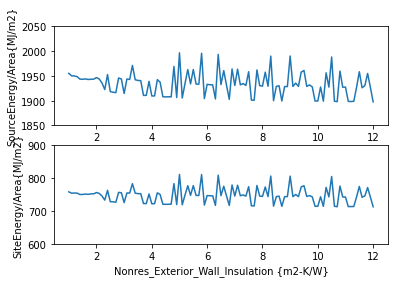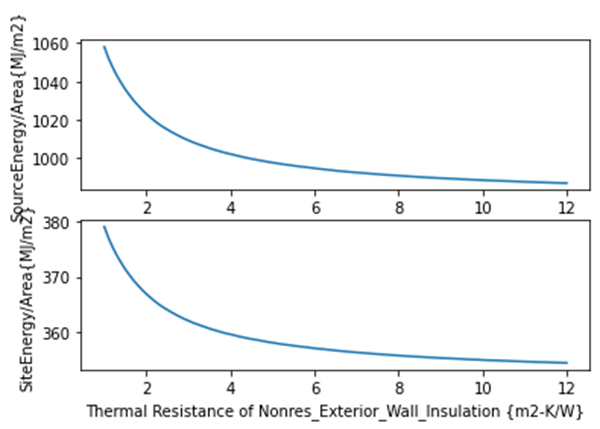The output of simulation is random
The model is the secondary school (ASHRAE90.1-2007) in the DOE commercial prototype building.
The weather file is the 2012 Rochester, NY (AMY data)
The version of EP+ is 9.0.1
When I was running the simulation, I noticed that sometimes the energy consumption will increase though I only increase the thermal resistance of the exterior wall. Since Rochester, NY belongs to the cold climate zone, the energy consumption should decrease when increasing the thermal resistance of the exterior wall.
I wrote a script for testing. During the testing, I only change the thermal resistance of the exterior wall. The value of thermal resistance of exterior wall (Nonres_Exterior_Wall_Insulation) is set between 1 to 12 m2-K/W. And the result shows that, in the beginning, the energy will decrease with the increased thermal resistance. But when the value exceeds a critical value (around 2.3 m2-K/W), the energy did not have a linear relationship with the thermal resistance of the exterior wall. It seems like the increasing and decreasing of energy is random.
The plot is shown below:

I'm not sure if this issue is caused by the model setting or the setting of EP+. If you have any similar experience, I would really appreciate it if you could give me any suggestions.
Further testing of medium office has been conducted. The medium office model (ASHRAE90.1-2019) is also from the DOE prototype building: https://www.energycodes.gov/prototype....
The results are shown below. These results definitely make sense.

I was wondering if it was caused by the complexity of the model? Once the model becomes complicated, the simulation in EP+ cannot get convergence.




Have you looked to be sure the indoor temperature is the same for this comparison?
Yes, the zone temperature is almost the same for each model.
Have you verified that for each of these runs the insulation level is as expected?
Yes, I've checked the models. Only the insulation value of the exterior wall has been changed. I also applied the same testing method to the Medium Office model (ASHRAE90.1-2019), which is also downloaded from DOE prototype commercial building website https://www.energycodes.gov/prototype.... The result of medium office is as expected. (I attached the picture in the content of the questions)